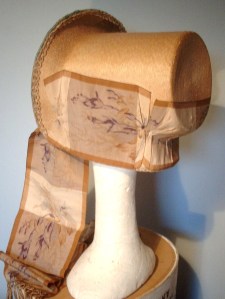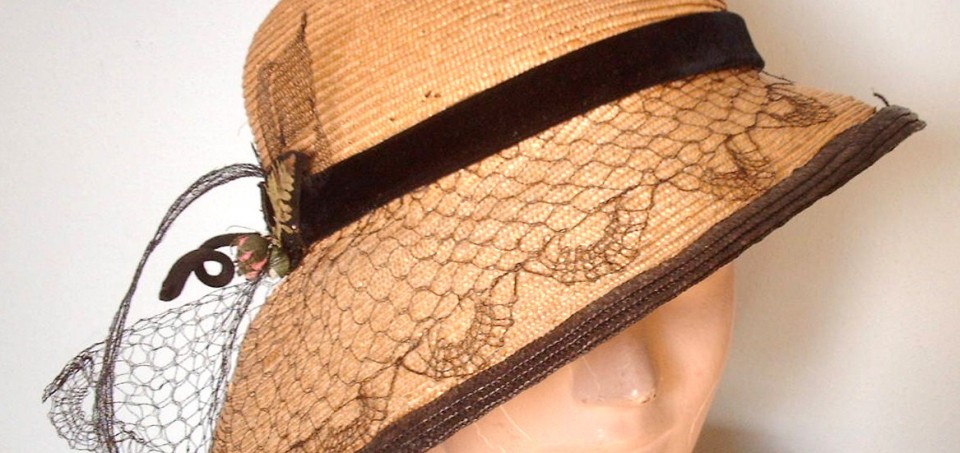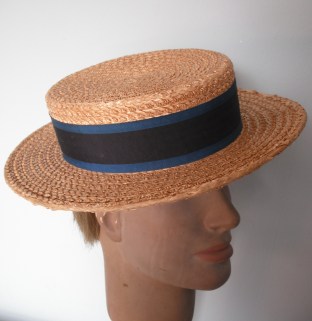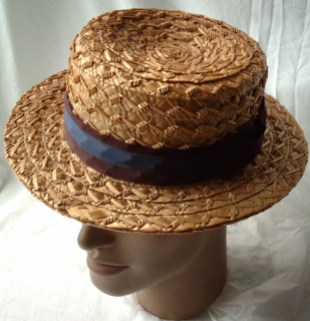
As you can see from the picture used as the ‘logo’ for HISTORY ON YOUR HEAD, straw, sisal, and other similar fibres can be made into the most elegant and useful creations. In use for hundreds, if not thousands of years, straw in some form or other has been worn on the heads of men and women, from commoners to kings, and I want to show you some of the variety of ways in which it can be used.

This example is of a similar date to the ‘logo’ hat; around 1910, and shows the huge crown so typical of the period.
The Collection has many examples, the oldest of which is around two hundred years old. It is very difficult to date hats, except by their style, and that becomes confusing when the style comes around again. Only by experience and ‘feel’ of items can one make an intelligent assessment. This is further complicated by the variety having come from so many different countries.

This is the oldest straw hat in the Collection, and dates from around 1815. A very similar one is in the National Trust’s Snowshill collection.
The ‘POKE BONNET’ shown on the left is made of extremely fine straw plait, and is lined with pale turquoise silk. The ribbon decoration is amazing, and shows fuchsia flowers bunched along its length. As mentioned on another page, a series of steel pins holds this in place…a matter of some concern, as the pins rust easily, causing damage.
In Britain, the main centre of straw hat making was the area around Luton in Bedfordshire. At the beginning of the nineteenth century, small children were put to work at what were known as PLAIT SCHOOLS. Children as young as three and four would be deemed old enough to produce some useful income for the family. Five and six year olds would spend all day working on lengths of plaited straw, which would then be collected into large bundles and taken to the Plait Market to be sold. Some of the straw used would be whole, other plaits were made using split straw, with many different numbers of strands and plait effects. The plait bundles were then taken home by the hat makers, where they were wetted, to make the fibres pliable, and then coiled and stitched into the desired hat shape. At first, this would have been done by hand, but with the introduction of the sewing machine in the 1850’s, it subsequently became possible to increase production, and instead of the hats being made in peoples homes as a cottage industry, the first factories came into being. Frequently they began in buildings attached to the rear of the home, and expanded from there. The High Town part of Luton was full of such premises.
Following a recent trip to Luton, where I was on a small (20 people) tour of the last remaining hat factory in the town, I was interested to discover that if straw is made into a hat, dampened, and then heated and pressed, it retains its shape and becomes quite hard…which explains how all those boaters keep so well .
picture of plait school..waiting for permission from Wardown Park Museum/Luton Archives.
Other straw hats were woven by hand sometimes in the most intricate of styles; starting in the centre, and working outwards, usually with the crown and brim made as a whole.  woven crown detail.
woven crown detail.
It is very difficult to determine the method used in the example above, but I have examined it closely, and can see no sign of it being stitched plait, despite the spiral effect, so can only deduce that it is a superb example of craftsmanship weaving. The hat itself is large, with a huge crown, a black velvet under-brim lining, and gathered crown lining in the manner of the early 1900’s; say about 1910. 
The pale turquoise example on the right is finely woven in sisal giving a totally different effect.
This hat was probably made in the 1980’s.

Above is another, completely different type of straw construction It is made using whole straw, showing off the length and shine of the stalks. It is quite rigid, but also fragile..being brittle with age. It is in remarkably good condition, and bears the label Jacoll inside. The Jacoll company started around 1917, and seems to be the brand name of J.Collett Ltd, a London based company. It is better known for hats of fabric and felt for women, but actually, made millions of uniform caps and hats for service personnel as well. It was particularly well known between the thirties and the sixties.
What most people think of as a ‘straw hat’ is usually a Boater. These are generally made of a thick, whole-straw plait, coiled and formed into the shape we know so well, and thoroughly stiffened, usually with shellac, until it became completely rigid. The examples below show two different styles…the plain one for everyday use by a schoolboy, the fancy one, made by a long established Luton company, for casual wear.
A boy’s boater,for Sherborne School A fancy boater by SNOXELL’s of LUTON
Snoxells are a very long- established Company in Luton , and are one of the very few hat makers still in existence today . They still manufacture a Boater, but I think it is only one style nowadays. Their main output currently, is glamorous hats for ladies, under the name Gwyther-Snoxell. There are several Snoxell boaters in the collection, all slightly different.
Straw hats for women are often regarded as mere sunhats; like the 1950’s sunhat shown here on the right. 
However, they were also made to show off the straw itself ,  as in this 1960’s ‘beehive’ shown on the left, by designer Otto Lucas, where the straw has been dyed various colours before construction.
as in this 1960’s ‘beehive’ shown on the left, by designer Otto Lucas, where the straw has been dyed various colours before construction.

The same applies to this 1930’s hat by Mmme. Suzy of Paris, with coloured detailing on the natural straw.
Straw was often merely a base for more elaborate hats; serving as a foundation on which to put so much decoration that the straw is hardly visible, This beret by Elsa Schiapparelli is adorned with pearls, beads , flowers and all manner of decoration, and dates probably from the 1950’s.
This beret by Elsa Schiapparelli is adorned with pearls, beads , flowers and all manner of decoration, and dates probably from the 1950’s.
Sometimes, even more straw is piled on, as on this mysterious hat who’s origins are unknown. It is probably from some part of Europe…..possibly Spain, but nothing definite has yet been found about it.

It was sold to me as being something to do with the Harvest Festival, or possibly Morris Dancing, but both these ideas have been discounted, and it remains an enigma. There is certainly some age to it, but impossible to estimate; I hesitate to even make a guess .

Above is a delightful straw bonnet. It is lined with white silk, and bears a label saying Selfridges. Right around the crown is an elaborate band of finely worked straw, a fascinating craft in its own right. Veronica Main, former curator of Wardown Park Museum in Luton, is an expert on what is known as Swiss Straw Work , and this intricate craft was also used for decorating hats. A modest example of this use of straw can be seen on this bonnet. Her book on the subject ( Swiss Straw Work, Main Collins Publishing, 2003) is a revelation as to what can be achieved by nimble fingers.

Everyone has heard of the PANAMA hat…..but they were actually made in Ecuador, and sold to people passing through the newly built Panama Canal originally. They are still being made today in the same way,and using the same material…extremely fine ‘esparto grass’, and the craftsmanship is amazing and time consuming. Here is a really old example showing a lot of wear. It was in use in the 1930’s when worn by a Norfolk Veterinary Surgeon, who must have had a very large head, as it is enormous ! Despite its age, it is still pliable, and could still probably be rolled up to shove in a pocket, as can the best of today’s panamas. The right hand picture shows a much more modern version, of the sort seen at sporting events, often made with inferior fibres.
And here is a lovely, recent acquisition. It is made quite roughly, of coarse straw, and adorned with a ‘ribbon’, woven in and out, of a wide, lustrous plant material, the like of which neither I nor knowledgeable folk of my acquaintance have been able to identify.

I love this hat. Its crown has a collapsible quality, meaning it takes up very little space in storage……although whether this is merely that it has collapsed with age, or that it was intentional, we shall never know ! It is adorned with small flowers, and the underside of the brim is lined with loosely pleated white silk.
 Inside is the Victorian/Edwardian sort of gathered lining, and a label printed in gold saying LAWTON BROTHERS of NANTWICH. Lawtons were a large haberdasher and milliners shop, at number 39 High Street . Sadly the shop is no longer selling the same sort of merchandise, but I believe the building is still there .
Inside is the Victorian/Edwardian sort of gathered lining, and a label printed in gold saying LAWTON BROTHERS of NANTWICH. Lawtons were a large haberdasher and milliners shop, at number 39 High Street . Sadly the shop is no longer selling the same sort of merchandise, but I believe the building is still there .
A good friend and I have opposing views on this hat. She thinks it may be 1930’s. I think it is a lot earlier ! Any comments welcomed.




